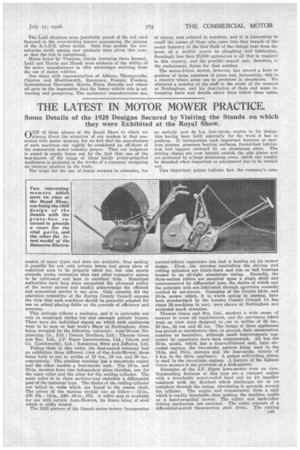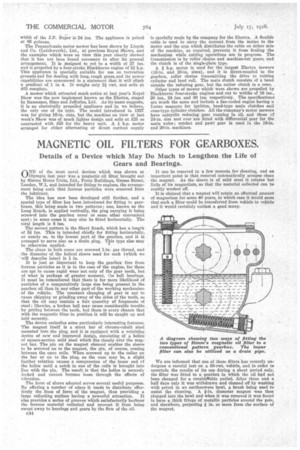THE LATEST IN MOTOR MOWER PRACTICE.
Page 65

Page 66

If you've noticed an error in this article please click here to report it so we can fix it.
Some Details of the 1928 Designs Secured by Visiting the Stands on which they were Exhibited at the Royal Show.
ONE of those phases of the Royal Show to which we always direct the attention of our readers is that concerned with motor mowers, for we feel that the manufacture of such machines can rightly be considered an off-shoot of the commercial motor industry proper. That our judgment is sound is surely borne out by the fact that one of the best-known of the range of these handy power-prOpelled appliances is produced in the works of a company occupying an eminent position in the trade.
The scope for the use of motor mowers is extensive, for models of many types and sizes are available, thus making it possible for not only private lawns and grass plots of restricted area to be properly cared for, but also sports grounds, parks, recreation sites and other expansive spaces to be cultivated and 'kept inexcellent trim. Municipal authorities have long since recognized the all-round utility of the motor mower and readily acknowledge the efficient and economical service it can give. Only recently did the education committee of the Surrey County Council express the view that such machines should be generally adopted for use on school playing fields on the grounds of efficiency and economy.
This attitude reflects a tendency, and it is noticeable not only in municipal circles but also amongst private buyers. There were six individual stands on which such appliances were to be seen at last week's Show at Nottingham, these being occupied by the following concerns: Auto-Mower Engineering Co., Ltd.; Dennis Brothers, Ltd.; Thomas Green and Son, Ltd., J.P. Super Lawnmowers, Ltd.; Lloyds and Co. (Letchworth),Ltd. ; Ransomes, Sims and Jefferies, Ltd.
Taking them in this order, the first-named company had on exhibition three different riieS of the Auto-Mower, these being built to cut to widths of 15 ins., 18 ins. and 30 ins., respectively. The smallest machine has a two-stroke engine and the other models a four-stroke unit. The 18-in. and 30-in, mowers have two independent plate clutches, one for the main roller and the other for the cutting cylinder. The main roller is in three sections-and embodies a differential gear of the motorcar type. The blades of the cutting cylinder are bolted to webs which are keyed to the centre shaft. The prices of the various models are as follow
£25 10s. ; 18-in., £40; 30-in., £75. A roller seat is available for use with certain Auto-Mowers, its frame being of steel which is stiffly braced.
The 1928 pattern a the Dennis motor mower incorporates
an entirely new 41 h.p. four-stroke engine in its design, this having been built especially for the work it has to perform. It incorporates such important features as castiron pistons, generous bearing surfaces, forced-feed lubrication and tappets enclosed by ari aluminium plate. The driving chains are now located outside the side plates and are protected by a large aluminium cover, which can readily be detached when inspection or adjustment has to be carried Out.
Two important points indicate how the company's coin
mercial-vehicle experience has .had a bearing on its mower design. First, the clutches controlling the driving and cutting cylinders are fabric-lined and run on ball bearings housed in an oil-tight aluminium casing. Secondly, the three-section rollers are mounted upon a single shaft and interconnected by differential gear, the shafts of which and the principle axis are lubricated through apertures normally covered by set-screws. Examples of the Dennis 24-in. and 30-in, mower which, it is worth noting in passing, have been standardized by the London County Council (it has about 50 machines in use), were shown at Nottingham and attracted much attention.
Thomas Green and Son, Ltd., markets a wide range of mowers to cover all requirements, and the specimens which were on view were designed to _cut to widths of 16 ins., 20 ins., 24 ins. and 42 ins. The design of these appliances has proved so satisfactory that, in general, their construction remains as heretofore, although small improvements suggested by experience have been incorporated. All but the 42-in, model, which has a four-cylindered unit, have aircooled engines, the two-stroke pattern being used in the 16-in. and 20-in, mowers and the four-stroke variety of 4 h.p. in the 24-in. appliance. A patent self-cooling piston is used in the two-stroke engines. A feature of the lightest Green mowers is the provision of a kick-starter.
Examples of the J.P. Super lawn-mower were on view. Outstanding features of this type are a compact engine with a detachable water-cooled head and an air impeller combined with the flywheel which discharges air at its periphery through the casing, circulating it upwards around the cylinder. The engine and transmission form a unit which is readily detachable, thus making the machine usable as a hand-propelled mower. The cutter and back-roller driving mechanism are enclosed. The roller consists of a differential-geared three-section steel drum. The cutting
width of the J.P. Sup' er is 24 ins. The appliance is priced at 65 guineas.
The Pennsylvania motor mower has been shown by Lloyds and Co. (Letchworth), Ltd., at previous Royal Shows, and the examples which were on view this year clearly showed that it has not been found necessary to alter its general arrangement. It is designed to cut to a width of 27 ins. and is propelled by a four-stroke Blaekburne engine of 2i h.p. This appliance is specially suitable for use on recreation grounds and for dealing with long, rough grass, and its power capabilities are announced in q statement that it will climb a gradient of 1 in 4. It weighs only 2j cwt. and sells at £65 complete.
A. mower which attracted much notice at last year's Royal Show was the new implement known as the Electra, staged by Ransomes, Sims and Jefferies, Ltd. As its name suggests, it is an electrically propelled appliance and is, we believe, the only one of its type. The model introduced in 1927 was for giving 16-in, cuts, but the machine on view at last week's Show was of much lighter design and sells at £25 as contrasted with £55 for the heavy unit. A h.p. motor arranged for either alternating or direct current supply is specially made by the company for the Electra. A flexible cable is used to carry the current from the mains to the motor and the arm which distributes the cable on either sideof the machine, as required, prevents it from fouling the mechanism while cutting operations are in progress. The transmission is by roller chains and machine-cut gears, and the clutch is of the single-plate type.
A h.p. motor is used for the largest Electra mowers (16-in. and 20-in. sizes), and it is direct-coupled to the gearbox, roller chains transmitting the drive to cutting cylinder and land roll. The main clutch consists of a band outside the reducing gear, but the cutter clutch is a cone.
Other types of mower which were shown are propelled by Blackburne four-stroke engines and cut to widths of 16 ins., 20 ins., 24 ins, and 30 ins. respectively, The specifications, are much the same and include a fan-cooled engine having a Lucas magneto for ignition, band-type main clutches and cone-type cylinder clutches. All the company's motor mowers have epicyclic reducing gear running in oil, and those cf 24-in, size and over are fitted with differential gear for the main axles ; ratchet and pawl gear is used in the 16-in. and 20-in. machines.












































































































